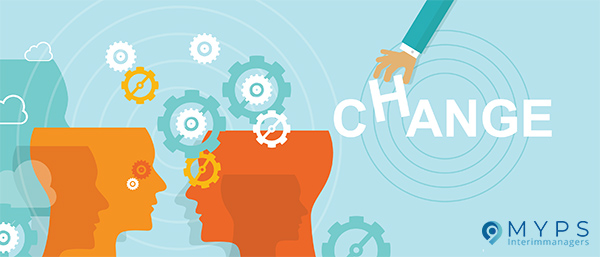
You don’t always need Change management. We have demonstrated in “change management part 1: you don’t always need it”, when you need training. For cases where that’s not enough, we worked on the next step, in “change management part 2: training is not enough” and we explained the RACI model and the concept of organisational development. In this blog post, we’ll touch on the situations where you do need the “full” change management, where sustainability is at stake, and more than training or organisational development is needed.
No sustainability without change management
In our previous blog, we elaborated on the cases where you do not need change management:
- Low impact, Low complexity: Training
Further to this, we worked on the concept of Train the Trainer.
2. Medium impact, medium complexity: Organisational Development
We discussed the complex/complicated differentiation, the concept of RACI.
And now, we have arrived at the final stage, where training and OD are not enough: the arena of major change, high impact on people and organisation:
3. High impact, High complexity: Change Management
Change is not welcome
In cities all over the world, an ugly war is being fought by “traditional” taxi companies against a new form of competition from Uber and other ride-sharing services. Instead of focusing on how they can respond to their customers’ new needs, taxi companies are coming up with strategies to continue business as usual.
Like the taxi companies, many businesses in other sectors are adapting to new challenges too slowly. They don’t see the change around them and think that their success is guaranteed due to their historic position in their industries. It is comfortable and reassuring in the short term, but dangerous and sometimes even deadly in the long term.
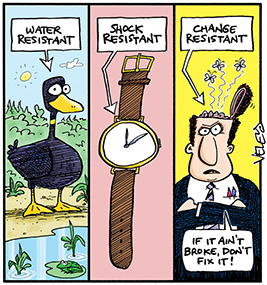
What is change management?
You can expect resistance to change. The previous 2 systems, training and organisational development, are easier to cope with for most involved. Once the change goes beyond a new procedure or a minor adjustment of the roles, you should be prepared to deal with the inevitable resistance.
We see a clear need for change management when:
– Your company is undergoing fundamental changes because of a transformation (either business or digital) or an ERP implementation
– A new production methodology is implemented, or GMP is introduced
– Your company decided to go for “continuous improvement”
– You encourage operational excellence or switch to a process driven approach
– After a merger, when you observe differences in cultural behavior, customer centricity or management systems
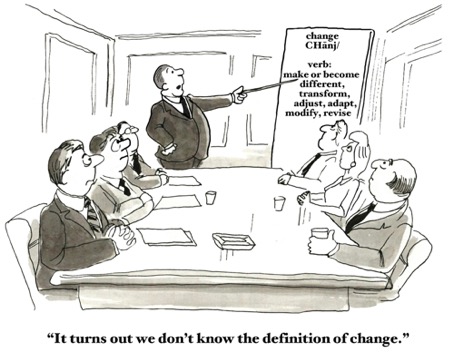
“Change management is the discipline that guides how we prepare, equip and support individuals to successfully adopt change in order to drive organisational success and outcomes” (PROSCI).
Is your organisation aware of change they need to implement? Good, brings up the question: HOW? We @ MYPS guide you through the full change process of your company and your people, using ‘The Magic 6’ model.
The Magic 6 model will allow you to properly categorise the changes within your company. Based on this, the proper actions can be defined and planned in order to smoothen your path of change from where you are today to your target.
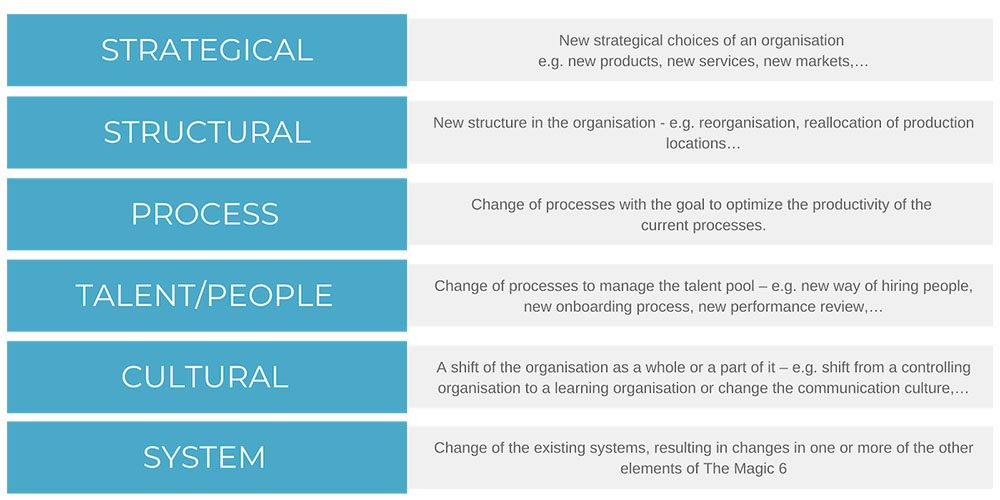
We believe nobody can ”think” his or her way out of change – you need to act your way through change. In most cases, it is advisable to have teams per category. For each change in their category, they define the approach, the actions and the methodology to be applied to go through the change.
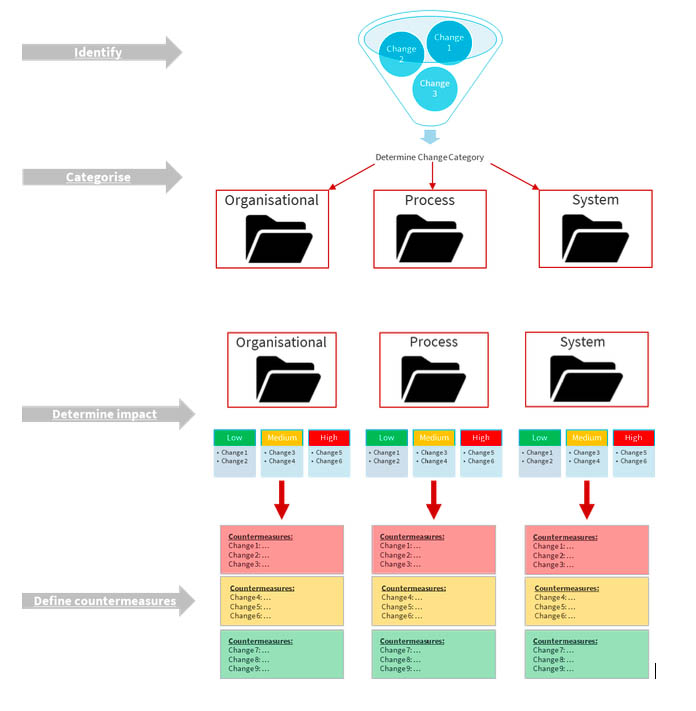
What’s the result of good change management?
This will allow you to structure the path you’re taking to make the change happen: it makes it objective, manageable, communicable.
You can’t think your way through change, you need to act your way through…
The result will be a better project:
– Realistic expectations from the start onwards; è too much blue sky often leads to thunderstorms
– A lower “valley of despair”, once the project is started è building bridges to bridge the valley
– Faster and better results, sustainable: è people experience in an iterative way small and sometimes large successes
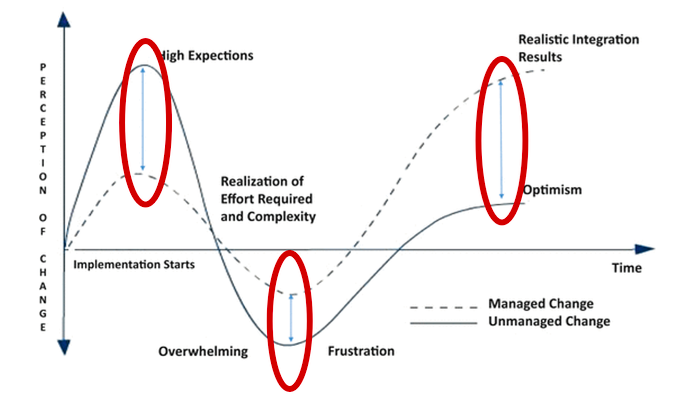
n a next blog we’ll discuss the human factor: the way people cope with change and the accompanying stress, and how we -managers- should handle resistance.
It will include agreed and useful reactions to specific behaviours, that people develop as they go through the swing of resistance.

You don’t always need Change management. We have demonstrated in “change management part 1: you don’t always need it”, when you need training. For cases where that’s not enough, we worked on the next step, in “change management part 2: training is not enough” and we explained the RACI model and the concept of organisational development. In this blog post, we’ll touch on the situations where you do need the “full” change management, where sustainability is at stake, and more than training or organisational development is needed.
No sustainability without change management
In our previous blog, we elaborated on the cases where you do not need change management:
- Low impact, Low complexity: Training
Further to this, we worked on the concept of Train the Trainer.
2. Medium impact, medium complexity: Organisational Development
We discussed the complex/complicated differentiation, the concept of RACI.
And now, we have arrived at the final stage, where training and OD are not enough: the arena of major change, high impact on people and organisation:
3. High impact, High complexity: Change Management
Change is not welcome
In cities all over the world, an ugly war is being fought by “traditional” taxi companies against a new form of competition from Uber and other ride-sharing services. Instead of focusing on how they can respond to their customers’ new needs, taxi companies are coming up with strategies to continue business as usual.
Like the taxi companies, many businesses in other sectors are adapting to new challenges too slowly. They don’t see the change around them and think that their success is guaranteed due to their historic position in their industries. It is comfortable and reassuring in the short term, but dangerous and sometimes even deadly in the long term.

What is change management?
You can expect resistance to change. The previous 2 systems, training and organisational development, are easier to cope with for most involved. Once the change goes beyond a new procedure or a minor adjustment of the roles, you should be prepared to deal with the inevitable resistance.
We see a clear need for change management when:
– Your company is undergoing fundamental changes because of a transformation (either business or digital) or an ERP implementation
– A new production methodology is implemented, or GMP is introduced
– Your company decided to go for “continuous improvement”
– You encourage operational excellence or switch to a process driven approach
– After a merger, when you observe differences in cultural behavior, customer centricity or management systems

“Change management is the discipline that guides how we prepare, equip and support individuals to successfully adopt change in order to drive organisational success and outcomes” (PROSCI).
Is your organisation aware of change they need to implement? Good, brings up the question: HOW? We @ MYPS guide you through the full change process of your company and your people, using ‘The Magic 6’ model.
The Magic 6 model will allow you to properly categorise the changes within your company. Based on this, the proper actions can be defined and planned in order to smoothen your path of change from where you are today to your target.

We believe nobody can ”think” his or her way out of change – you need to act your way through change. In most cases, it is advisable to have teams per category. For each change in their category, they define the approach, the actions and the methodology to be applied to go through the change.

What’s the result of good change management?
This will allow you to structure the path you’re taking to make the change happen: it makes it objective, manageable, communicable.
You can’t think your way through change, you need to act your way through…
The result will be a better project:
– Realistic expectations from the start onwards; è too much blue sky often leads to thunderstorms
– A lower “valley of despair”, once the project is started è building bridges to bridge the valley
– Faster and better results, sustainable: è people experience in an iterative way small and sometimes large successes

n a next blog we’ll discuss the human factor: the way people cope with change and the accompanying stress, and how we -managers- should handle resistance.
It will include agreed and useful reactions to specific behaviours, that people develop as they go through the swing of resistance.


